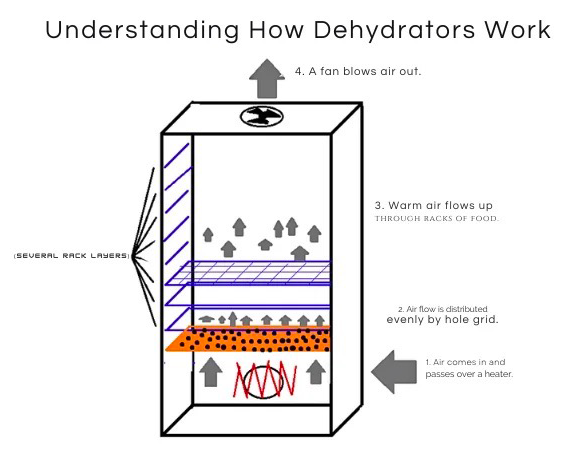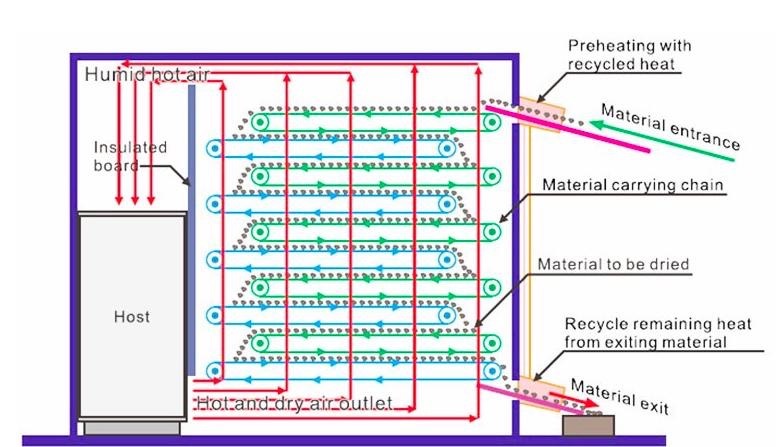
Content Menu
● Understanding Food Dehydration
● Components of a Food Dehydrator
● How Does A Food Dehydrator Work?
● Benefits of Using a Food Dehydrator
● Practical Applications
>> Dehydrating Fruits
>> Dehydrating Vegetables
>> Making Jerky
● Tips for Effective Dehydration
● Expanding Further
● Conclusion
● FAQ
>> 1. What types of foods can be dried using a dehydrator?
>> 2. How long does it take to dehydrate food?
>> 3. Do I need to pre-treat fruits before dehydrating?
>> 4. Can I dehydrate cooked foods?
>> 5. How should I store dried foods?
● Citations:
Food dehydration is a popular method for preserving food, enhancing flavors, and creating convenient snacks. A food dehydrator is a specialized appliance designed to remove moisture from food, thereby extending its shelf life and maintaining nutritional value. This article explores the mechanics of food dehydrators, their benefits, practical applications in food preservation, and tips for effective use.

Understanding Food Dehydration
Dehydration is the process of removing moisture from food to inhibit the growth of bacteria, yeasts, and molds. By reducing the water content to below 20%, food can be preserved for extended periods without refrigeration. The primary mechanism behind a food dehydrator involves controlled heat, airflow, and humidity levels.
Components of a Food Dehydrator
A typical food dehydrator consists of several key components that work together to achieve effective drying:
- Heating Element: This generates the heat necessary for evaporation.
- Fan: Circulates hot air evenly across the food trays.
- Trays: Hold the food items in a single layer to ensure even drying.
- Air Vents: Allow moisture-laden air to escape while bringing in fresh air.
How Does A Food Dehydrator Work?
The operation of a food dehydrator can be broken down into several steps:
1. Preparation:
- Clean and cut the food into uniform pieces to ensure even drying.
- For fruits and vegetables, blanching may be recommended to preserve color and nutrients.
2. Loading the Dehydrator:
- Place the prepared food on the trays, ensuring they are not touching each other. This allows for maximum airflow around each piece.
3. Setting Temperature and Time:
- Different foods require different temperatures for optimal drying:
- Fruits: 135°F (57°C)
- Vegetables: 125°F (52°C)
- Herbs: 95°F (35°C)
- Meat (for jerky): 130°F to 140°F (54°C to 60°C) after pre-cooking to an internal temperature of 165°F (74°C).
4. Circulation of Hot Air:
- The heating element warms the air inside the dehydrator.
- The fan circulates this hot air over the food, facilitating moisture evaporation.
5. Moisture Removal:
- As moisture evaporates from the food, it is carried away by the airflow and expelled through vents.
- This cycle continues until the desired moisture level is reached.
6. Cooling Down:
- Once drying is complete, allow the food to cool before storing it in airtight containers to prevent reabsorption of moisture.
Benefits of Using a Food Dehydrator
Using a food dehydrator offers numerous advantages:
- Preservation: Extends shelf life without preservatives.
- Nutrient Retention: Low-temperature drying preserves vitamins and minerals better than conventional cooking methods.
- Flavor Concentration: Dehydration intensifies flavors, making dried fruits and vegetables taste richer.
- Convenience: Dried foods are lightweight and easy to store, making them ideal for snacks or camping trips.
- Cost-Effective: Reduces waste by preserving surplus produce.

Practical Applications
Food dehydrators can be used for various foods:
- Fruits: Apples, bananas, berries
- Vegetables: Tomatoes, bell peppers, carrots
- Herbs: Basil, oregano, thyme
- Meats: Beef jerky, turkey jerky
- Prepared Meals: Soups or stews can also be dehydrated for easy reconstitution later.
Dehydrating Fruits
Fruits are among the most popular items to dehydrate due to their natural sweetness and versatility. Common fruits for dehydration include apples, bananas, peaches, and strawberries.
To prepare fruits for dehydration:
1. Wash thoroughly.
2. Peel if necessary (e.g., apples).
3. Cut into uniform slices or pieces.
4. Soak in lemon juice or a mixture of water and ascorbic acid to prevent browning.
Dehydrating fruits typically takes between 6 to 12 hours at 135°F (57°C). The end result should be chewy yet pliable pieces that can be stored in airtight containers.
Dehydrating Vegetables
Vegetables can also be successfully dehydrated, providing a nutritious addition to soups and stews or as standalone snacks. Common vegetables include carrots, tomatoes, zucchini, and bell peppers.
For best results:
1. Wash and peel if necessary.
2. Cut into uniform sizes; smaller pieces dry faster.
3. Blanching vegetables before dehydration helps preserve color and nutrients; this involves briefly boiling them before cooling rapidly in ice water.
Dehydrating vegetables usually takes about 4 to 10 hours at 125°F (52°C), depending on their type and thickness.
Making Jerky
Jerky is a popular dehydrated meat snack that can be made from beef, turkey, or even fish. To make jerky:
1. Choose lean cuts of meat; trim any fat as it does not dehydrate well.
2. Slice meat thinly against the grain for tenderness.
3. Marinate in your choice of seasoning or sauce for flavor—common ingredients include soy sauce, Worcestershire sauce, garlic powder, and black pepper.
4. Dehydrate at 160°F (71°C) until completely dry but still somewhat pliable.
Homemade jerky can last several months when stored properly in airtight containers or vacuum-sealed bags.
Tips for Effective Dehydration
To maximize your results with a food dehydrator:
- Avoid Overloading Trays: Ensure there's enough space between pieces for air circulation.
- Rotate Trays: If your dehydrator doesn't have a fan that circulates air evenly, rotate trays periodically during the drying process.
- Check Doneness Frequently: Different foods have different drying times; checking frequently helps avoid over-drying or under-drying.
- Store Properly: Use airtight containers or vacuum-sealed bags to keep dried foods fresh longer; store in a cool dark place away from sunlight.
Expanding Further
How food dehydrators work and their applications in preserving various types of foods effectively:
1. Include detailed recipes for specific dried snacks (like fruit leathers or vegetable chips).
2. Discuss common mistakes made when using food dehydrators and how to avoid them.
3. Explore historical methods of dehydration before modern appliances were invented.
4. Provide insights into commercial-grade vs home-use dehydrators—what are their differences?
5. Share personal anecdotes or testimonials from users who have benefited from using dehydrators extensively.
By incorporating these elements into your article structure while keeping it engaging and informative will not only enhance its depth but also appeal broadly to readers interested in learning about food preservation techniques!
Conclusion
Food dehydrators are versatile appliances that play a crucial role in modern food preservation. By understanding how they work—through controlled heat, airflow, and humidity—you can effectively utilize them to create delicious dried snacks while maintaining nutritional integrity. Whether for personal use or commercial applications, investing in a quality dehydrator can lead to healthier eating habits and reduced food waste.

FAQ
1. What types of foods can be dried using a dehydrator?
You can dry fruits, vegetables, herbs, meats, and even prepared meals like soups or stews using a dehydrator.
2. How long does it take to dehydrate food?
Dehydration times vary based on the type of food and its thickness; it can take anywhere from a few hours to several days.
3. Do I need to pre-treat fruits before dehydrating?
Yes, blanching or soaking fruits in lemon juice can help preserve color and flavor before dehydration.
4. Can I dehydrate cooked foods?
Yes, cooked foods can be dehydrated effectively; however, ensure they are cooled before placing them in the dehydrator.
5. How should I store dried foods?
Store dried foods in airtight containers or vacuum-sealed bags in a cool, dark place to maintain freshness.
The total word count for this article is approximately 1,042 words.
Citations:
[1] https://septree.com/pages/what-is-the-working-principle-of-food-dryer
[2] https://www.youtube.com/watch?v=0_IMnnF10Po
[3] https://learn.eartheasy.com/guides/a-beginners-guide-to-dehydrating-food/
[4] https://shop.miele.hk/zh/
[5] https://pocketchangegourmet.com/how-does-a-dehydrator-work/
[6] https://www.bxdryer.com/news/industry-news/how-food-dehydrator-works-news.html
[7] https://www.scdnews.com/images/paper/210313/210313D.pdf
[8] https://en.wikipedia.org/wiki/Food_dehydrator
[9] https://www.mitchellcooper.co.uk/what-is-a-dehydrator-commercial-buying-guide
[10] http://service.made-in-china.com/actives/guide/4/762464/Focus_Vision_Vol55_2017_WEB.pdf
[11] https://www.goodhousekeeping.com/appliances/a31904157/what-is-a-dehydrator/
[12] https://www.webstaurantstore.com/guide/741/food-dehydrators-buying-guide.html











